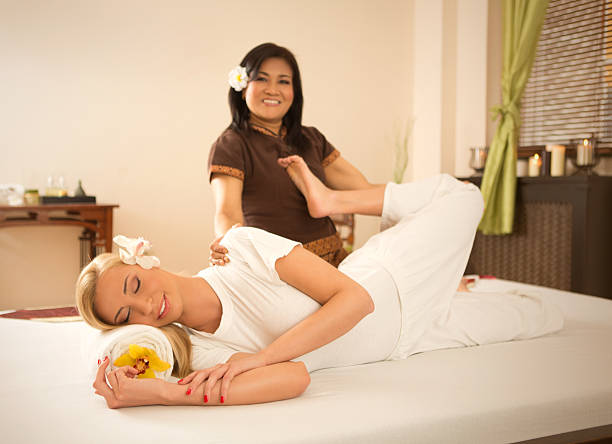Thai Massage: History, Techniques, Benefits, and Modern-Day Relevance?

Thai massage, also known as Nuad Thai or traditional Thai massage, is a healing practice that blends acupressure, yoga-like stretching, and body alignment techniques. Unlike many Western forms of massage that focus primarily on muscle relaxation using oils, Thai massage emphasizes energy flow, mobility, and overall well-being. A typical session involves the recipient wearing comfortable clothes while lying on a floor mat as the practitioner uses their hands, elbows, knees, and feet to stretch, press, and manipulate the body.
Recognized globally for its therapeutic and rejuvenating effects, Thai massage has grown into a popular practice not only in Thailand but also in wellness centers, spas, and rehabilitation clinics worldwide. In 2019, UNESCO even listed Traditional Thai Massage as part of the Intangible Cultural Heritage of Humanity, highlighting its cultural and historical importance.
The History of Thai Massage
The origins of Thai massage can be traced back more than 2,500 years. According to tradition, its roots lie in the work of Jivaka Kumar Bhaccha, a physician from ancient India who was a contemporary of the Buddha. Over time, this healing art was influenced by Ayurvedic practices, traditional Chinese medicine, and local Thai folk traditions.
In Thailand, massage was historically considered a community practice. Villagers often learned the techniques informally and passed them down through generations. There were also more formalized versions known as royal massage, which followed stricter etiquette and techniques suitable for the royal court.
The temple of Wat Pho in Bangkok remains one of the most significant institutions for Thai massage training. It has preserved many traditional methods and is considered a birthplace of structured Thai massage education. Today, it attracts students and practitioners from around the world.
Core Techniques of Thai Massage
One of the most distinctive aspects of Thai massage is its unique blend of stretching, acupressure, and energy balancing. Here are the key techniques commonly used in sessions:
Acupressure and Energy Lines (Sen Lines)
Thai massage is based on the concept of invisible energy pathways called Sen lines, similar to meridians in Chinese medicine. Practitioners apply pressure using thumbs, palms, elbows, or feet to release blockages, improve circulation, and restore balance.
Assisted Stretching
A hallmark of Thai massage is its yoga-like stretches. Practitioners move clients into different postures to gently extend muscles, improve flexibility, and increase joint mobility. This makes Thai massage particularly effective for people with stiffness or limited range of motion.
Rhythmic Rocking and Compression
Movements often include gentle rocking, rhythmic pressing, and compression of muscles. These techniques stimulate blood flow, relax the nervous system, and create a soothing effect.
Use of the Whole Body
Unlike many massages that rely mainly on hands, Thai massage incorporates the use of elbows, knees, and even feet. This allows practitioners to apply deeper pressure and assist with full-body stretches.
Mindful Breathing and Flow
Sessions often emphasize mindful breathing and a meditative approach, creating a holistic healing environment. Both the client and practitioner benefit from the sense of calm and focus.
What to Expect in a Thai Massage Session
If you are new to Thai massage, here is what typically happens during a session:
Clients remain fully clothed in loose, comfortable garments. Massage usually takes place on a padded mat on the floor rather than a massage table. A session can last between 60 to 120 minutes, and the practitioner guides you through stretches, applies pressure along energy lines, and may use rocking motions to loosen muscles. Some stretches may feel intense, but the overall effect is energizing and deeply relaxing.
Health Benefits of Thai Massage
Scientific studies and centuries of practice support the health benefits of Thai massage. Below are some of the most recognized advantages:
Pain Relief
Thai massage has been shown to reduce chronic pain, especially in the lower back, shoulders, and joints. Research indicates that it can ease symptoms of osteoarthritis and improve physical comfort.
Improved Flexibility and Mobility
The assisted stretches increase joint range of motion and muscle flexibility, which can benefit athletes, office workers, and elderly individuals.
Stress Reduction and Relaxation
The rhythmic, meditative style of Thai massage helps lower stress, reduce anxiety, and promote mental calmness. Clients often leave sessions feeling both energized and relaxed.
Better Circulation
The compressions and stretches stimulate blood and lymph flow, improving overall circulation and aiding in detoxification.
Headache Relief
Some studies suggest that Thai massage may help reduce the frequency and intensity of tension headaches and migraines.
Enhanced Posture and Alignment
By loosening tight muscles and mobilizing joints, Thai massage helps improve posture and spinal alignment.
Risks and Contraindications
While Thai massage offers many benefits, it is not suitable for everyone. Risks may include soreness, bruising, or overstretching if performed improperly. People with the following conditions should consult a doctor before receiving Thai massage:
- Severe osteoporosis
- Heart disease or uncontrolled high blood pressure
- Recent surgery or injuries
- Pregnancy (unless with a trained prenatal practitioner)
- Herniated discs or spinal issues
As with any therapeutic practice, it is essential to choose a trained, licensed therapist to avoid injury.
Thai Massage in Modern Times
Thai massage has evolved into both a traditional healing art and a commercial wellness service. Here’s how it fits into modern life:
Global Popularity
Spas and wellness centers worldwide now offer Thai massage. It is especially popular in Europe, North America, and Australia, where it is valued for its unique approach and holistic benefits.
Medical Applications
In Thailand, some hospitals and rehabilitation centers incorporate Thai massage into treatment plans for pain relief and physical recovery.
Fusion Styles
Modern spas sometimes blend Thai massage with aromatherapy, hot stones, or Swedish massage techniques, creating hybrid experiences tailored to clients’ preferences.
Tourism and Economy
Thai massage is a major part of Thailand’s wellness tourism industry. Travelers often seek authentic experiences at massage schools, local spas, or temples such as Wat Pho.
Cultural and Spiritual Significance
Thai massage is not just about physical well-being; it also carries spiritual and cultural meaning. Practitioners often begin with a prayer or wai khru ceremony, paying respect to their teachers and lineage. The practice embodies principles of compassion, mindfulness, and balance, reflecting Buddhist influences.
For many Thais, massage is also a form of community care, with families and neighbors practicing informal techniques at home. This sense of connection enhances its role as both a healing art and a cultural treasure.
Practical Tips Before Getting a Thai Massage
If you are planning to experience Thai massage, here are some practical suggestions:
- Wear comfortable, loose-fitting clothes
- Avoid heavy meals before your session
- Communicate openly with your therapist about any pain, injuries, or health conditions
- Expect some intensity during stretches but never sharp pain
- Drink water afterward to help flush out toxins and rehydrate your body
Conclusion
Thai massage is a unique and powerful practice that blends tradition, spirituality, and therapeutic benefits. Its ancient roots, holistic techniques, and modern applications make it one of the most respected forms of bodywork in the world. Whether you are seeking pain relief, flexibility, stress reduction, or simply a rejuvenating experience, Thai massage offers a pathway to physical and mental well-being.
As it continues to spread globally, Thai massage remains both a cultural heritage of Thailand and a valuable part of the modern wellness industry. By choosing a qualified practitioner and approaching it with an open mind, you can experience its transformative effects firsthand.




